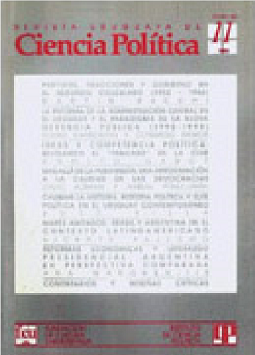Beyond polyarchy
an approximation to the quality of democracies
Keywords:
Democracy, PolyarchyAbstract
This paper compares the quality of democracy in 58 polyarchies. The authors claim that formal extensions of the rights of participation and opposition usually do not imply a substantial improvement once the "procedural minimum" has been achieved. To assess the quality of democracies levels of effective participation and political contestation are mesured in each country. Based on legislative data, the article developes an index of political competitiveness and an index of effective opposition. The use of ANOVA and regression analysis allows to show that institutional arrangements are a necessary but not sufficient condition for quality of democracy.
Downloads
References
Bollen, K. (1980). Issues in the Comparative Measurement ofPolitical Democracy. American Sociological Review, 45, 370-90.
Bollen, K. (1993). Liberal democracy: validity and method factors in cross-national measures. American Journal ofPolitical Science, 37, 1207-30.
Centellas, Miguel. (1999). The Consolidation of Polyarchy in Bolivia, 1985-97. Ponencia presentada en el 57th congreso anual de la Midwest Political Science Association' (MPSA), Chicago 15 al 17 de abril.
Collier, D. y Levitsky, S. (1994). Democracy with adjectives: Finding conceptual order in recent comparative research. Ponencia presentada en el congreso anual de la American Political Science Association. New York, Septiembre 1-4.
Coppedge, M. Y Reinicke, W. (1991). Measuring Polyarchy. En A. Inkeles (Comp.), On measuring democracy: its consequences and concomitants (pp. 47-68). New Brunswick:
Transaction Publishers.
Coppedge, Michael (1997). Modernization and Thresholds of Democracy: .Evidence for a Cornmon Path and Process. En M. Midlarsky (Comp.), 1nequality, Democracy, and Economic Development. (pp. 177-201). Cambridge: Cambridge University Press.
Cox, G. (1988). Closeness and Turnout: a . Methodological Note. Journal of Politics, 50, 768-775.
Cox, G. y Munger M. (1989). Closeness, Expenditures and Turnout in the 1982 House Elections. American Political Science Review, '183,217-231.
Cutright, P. (1963). National Political Development: Measurement and Analysis. American Sociological Review, 28, 253-64.
Dahl, R. (1956). A preface to democratic theory. Chicago: University ofChicago Press.
Dahl, R (1971). Polyarchy; Participation and opposition. New Haven: Yale University Press.
Dahl, R (1989). Democracy and its critics. New Haven: Yale University Press.
Diamond, L. (1996). Is the Third Wave of Democratization Over? Stanford, CA: Hoover Institution.
Downs, A. (1957). An economic theory of democracy. New York: Harper.
Gastil, R D. (1991). The Comparative Survey of Freedom: Experiences and Suggestions.En A. Inkeles (Comp.), On measuring democracy: its consequences and concomitants
(pp. 21-46). New Brunswick: Transaction Publishers.
Gurr, T. R, Jaggers, K. y Moore, W. H. (1990). The Transformation ofthe Western State: The Growth of Democracy, Autocracy, and State. Power since 1800. Studies in Comparative 1nternational Development, 25, 73-108.
Hadenius, A. (1992). Democracy and development. Cambridge; New York: Cambridge University Press.
Hill, K. Q. (1994). Democracy in thefifty states. Lincoln: University of Nebraska Press.
Hill, K. Q. Y Leighler J. (1993). Party Ideology, Organization, and Competitiveness as Mobilizing Forces in Gubernatorial Elections. American Journal of Political Science, 37,
1158-1178 .
Kenney, C. (1996). ¿Por qué el autogolpe? Fujimori y el Congreso, 1990-1992. En Los Enigmas del Poder: Fujimori 1990-1996,comp. Fernando Tuesta Solde villa. Lima: Fundación Friedrich Ebert.
Lerner, D. (1958). The passing oftraditional society: modernizing the Middle East. Glencoe, IL.: The Free Press.
Lijphart, A. (1984). Democracies. Patterns of Majoritarian and Consensus Government in Twenty-One Countries. New Haven: Yale University Press.
Mackie, T. y Rose R. (1991). The international almanac of electoral history. Washington, D.C.: Congressional Quarterly.
Mainwaring, S. y Perez-Linan,A. (1997). Party Discipline in the Brazilian Constitutional Congress. Legislative Studies Quarterly, 22, 453-483
Molina, J. E. 1989. La Participación Electoral en Venezuela. San José: CAPEL Nohlen, D. (Comp.). (1993). Enciclopedia electoral latinoamericana y del Caribe. San José, Costa Rica: Instituto Interamericano de Derechos Humanos.
O'Donnell, G. (1993). On the state, democratization and sorne conceptual problems: a Latin American view with glances at sorne postcommunist countries. World Development, 21,1355-1369.
O'Donnell, G. (1996). Illusions about consolidation. Journal of Democracy, 7, 34-51.
Pateman, C. (1970). Participation and democratic theory. Cambridge: Cambridge University Press.
Patterson, S. y Caldeira, G. (1983). Getting Out the Vote: Participation in Gubernatorial Elections. The American Political Science Review, 77, 675-689.
Pérez Liñán, Aníbal. (1998). El estudio de la democracia en perspectiva comparada: nuevas preguntas, viejas respuestas. Postdata (Buenos Aires), 3-4, 221-241.
Powell, G. B. (1986). American Voter Turnout ~~h Comparative Perspective. The American Political Science Review, 80, 17-43.
Putnam, R. D. (1993). Making democracy work: Civic tradiÚons in modern Italy. Princeton, N.J.: Princeton University Press.
Ranney, A. (1965). Parties in State Politics. En H. Jacob y K. Vines (Comps.), Politics in the American States. Boston: LittIe, Brown
Sartori, G. (1976). Parties and party systems : Aframework for analysis. Cambridge; New York: Cambridge University Press.
Schattschneider, E. E. (1960). The semisovereign people: A realist's view of democracy in America. New York: HoIt, Rinehart and Winston.
Schumpeter, J. A. (1947). Capitalism, socialism, and democracy. New York: Harper & Brothers.
Settle, R. Y Abrams, B. (1976). The Determinants of Voter Participation: A More General Model. Public Choice, 27, 81-89.
Sklar, R. (1987). Developmental Democracy. Comparative Studies in Society and History, 29,686-714
Teixeira, R. A. (1987). Why Americans don't vote: Turnout decline in the United States, 1960-1984. New York: Greenwood Press.
Valenzuela, S. (1992). Democratic consolidation in post-transitional settings: Notion, process and facilitating conditions. En S.Mainwaring, G. O'Donnell y S. Valenzuela
(Comps.), Issues in Democratic Consolidation: The New South American Democracies in Comparative Perspective. N otre Dame, IN: University of Notre Dame Press.
Vanhanen, T. (1984). The Emergence of Democracy; A Comparative Study of 119 States,1850-1979. Helsinki: Societas Scientiarum Fennica.



























